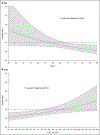Antithrombotic Treatment of Embolic Stroke of Undetermined Source: RE-SPECT ESUS Elderly and Renally Impaired Subgroups
- PMID: 32404035
- PMCID: PMC7379165
- DOI: 10.1161/STROKEAHA.119.028643
Antithrombotic Treatment of Embolic Stroke of Undetermined Source: RE-SPECT ESUS Elderly and Renally Impaired Subgroups
Abstract
Background and Purpose- The RE-SPECT ESUS trial (Randomized, Double-Blind, Evaluation in Secondary Stroke Prevention Comparing the Efficacy and Safety of the Oral Thrombin Inhibitor Dabigatran Etexilate Versus Acetylsalicylic Acid in Patients With Embolic Stroke of Undetermined Source) tested the hypothesis that dabigatran would be superior to aspirin for the prevention of recurrent stroke in patients with embolic stroke of undetermined source. This exploratory subgroup analysis investigates the impact of age, renal function (both predefined), and dabigatran dose (post hoc) on the rates of recurrent stroke and major bleeding. Methods- RE-SPECT ESUS was a multicenter, randomized, double-blind trial of dabigatran 150 or 110 mg (for patients aged ≥75 years and/or with creatinine clearance 30 to <50 mL/minute) twice daily compared with aspirin 100 mg once daily. The primary outcome was recurrent stroke. Results- The trial, which enrolled 5390 patients from December 2014 to January 2018, did not demonstrate superiority of dabigatran versus aspirin for prevention of recurrent stroke in patients with embolic stroke of undetermined source. However, among the population qualifying for the lower dabigatran dose, the rate of recurrent stroke was reduced with dabigatran versus aspirin (7.4% versus 13.0%; hazard ratio, 0.57 [95% CI, 0.39-0.82]; interaction P=0.01). This was driven mainly by the subgroup aged ≥75 years (7.8% versus 12.4%; hazard ratio, 0.63 [95% CI, 0.43-0.94]; interaction P=0.10). Stroke rates tended to be lower with dabigatran versus aspirin with declining renal function. Risks for major bleeding were similar between treatments, irrespective of renal function, but with a trend for lower bleeding rates with dabigatran versus aspirin in older patients. Conclusions- In subgroup analyses of RE-SPECT ESUS, dabigatran reduced the rate of recurrent stroke compared with aspirin in patients qualifying for the lower dose of dabigatran. These results are hypothesis-generating. Aspirin remains the standard antithrombotic treatment for patients with embolic stroke of undetermined source. Registration- URL: https://www.clinicaltrials.gov; Unique identifier: NCT02239120.
Keywords: anticoagulants; atrial fibrillation; cardiovascular disease; risk factors; secondary prevention.
Figures




